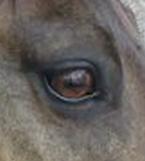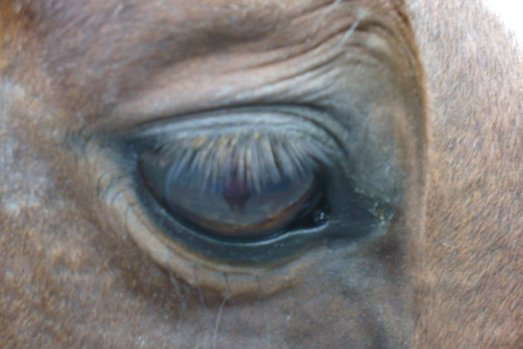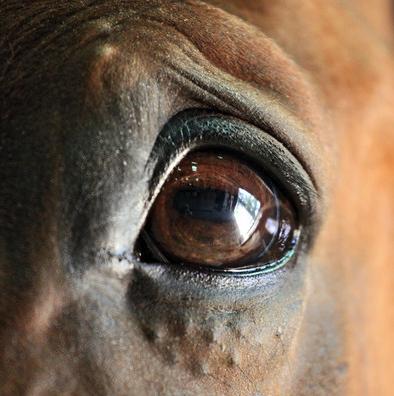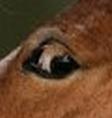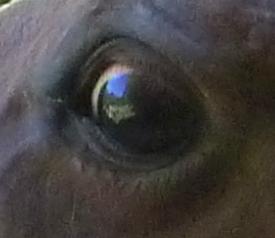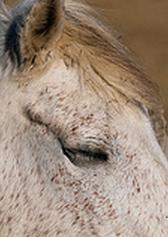I believe that a major part of being an efficient rider is to understand how every part of the horse works. If you don’t understand why a horse is reacting a certain way, you may end up punishing something the horse truly has no control over or brushing off some uncalled for action that is fully correctable. One of the biggest issues that really bothers me is when people punish their horse for spooking. Many of the reasons a horse spooks are found in his biological makeup and cannot be altered.

The equine eye is the largest orb found in any land mammal. Therefore, the horse has the capacity to take in a large amount of visual information at once. It also means that a horse’s retina (the part that transfers information to the brain via the optic nerve to form images) is much larger than any other land mammal and because of this any object that a horse sees will look roughly 50% larger to him than it would to us. This is the first reason many things seem scary to your horse.
Now, as (I believe) is common knowledge, horses are animals of prey. In the wild, they are the ones that are hunted. Nature, being the wonderful thing that it is, supplied the horse ways of protecting itself. One of these ways is having a very large visual field. While most predators like humans, dogs and cats have 180° vision, horses have almost 350° of sight because of the placement of their eyes widespread on the side of their head instead of close together and in front. However, the horse’s ability to take in so much visual information at once can also make the world seem like a scarier place. A horse is made visually aware of something by movement, so trail riding on a windy day can make a horse seem a little more jittery than normal because there is SO much stimulating his sense of sight.
Humans are very used to looking at something and immediately knowing, with clarity, what the object in front of us is. Our eyes have a sort of ‘auto-focus’ so that whether the object is 10 inches or 10 yards away, we can see it clearly by simply glancing at it. The simple explanation for this is 2-parted:
- 1) Our ciliary muscle in the eye is well-developed. That’s the part that adjusts the shape of the lens allowing us to focus. It works quickly to let our eye focus immediately.
- 2) Our retina, like many mammals, is smooth and concave, allowing for even focus in the eye.
The horse has an incredibly underdeveloped ciliary muscle. This means that it takes much longer for a horse to focus on something than it does for us. Imagine the speed of using auto-focus on a camera instead of manual focus. Also, the horse’s retina is concave, but the surface is not smooth. This means that some parts of the horse’s eye allow for better focus and clarity than other spots, which is why a horse may lower or raise his head, or weave his head side-to-side when he is trying to see something.
Not only does the horse have to work hard to focus, he has to figure out what exactly he needs to focus on. The human eye sees with binocular vision, meaning that our brain gives us 1 single picture from the information that both eyes take in. A horse has a small binocular field of vision, but roughly 270° of a horse’s sight is monocular. This means that the horse’s brain is receiving two images at once because each eye is sending a different picture. Imagine watching side-by-side television and trying to focus on both pictures at the same time. It is nearly impossible to clearly see one picture or the other without turning your head to look directly at it. This is the way a horse’s vision works. His field of binocular vision begins about 6 inches to a foot from his forehead and extends in front of him. Keep in mind that those 6-12 inches are a blind spot, which is why a pat between the eyes may elicit a flinch or even full-fledged spook. His monocular field of vision surrounds nearly the rest of his body, except for a small blind spot just next to his flanks and directly behind him. By turning his head he can eliminate the blind spot on one side or the other.

The basics of how a horse sees
Knowing how a horse sees affects the way that we work with them. Don’t get mad at your horse for spooking at something because even though you recognized it right away, it may have taken your horse by surprise and looked scary and fuzzy to him. Always work from both sides of your horse so that he is used to a motion being performed on each side of him. Because of monocular vision, an action done on one side will become an entirely new experience on the other side because the brain is getting a whole new set of images from the opposite eye, so don’t expect your horse to be perfect as soon as you change direction or sides.
Patience is key when it comes to effective work with horses. You and your horse are capable of great things if you take the time to understand him!

